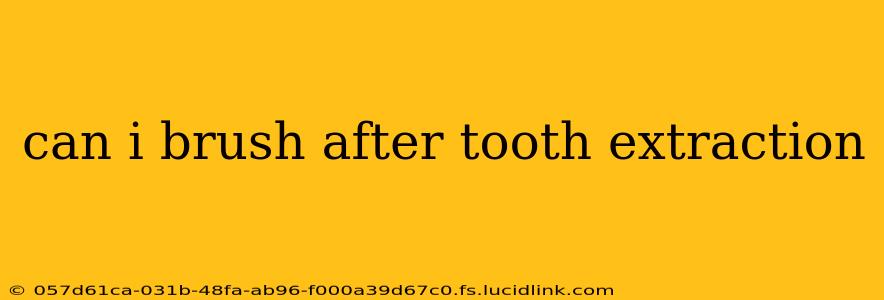Losing a tooth, whether through extraction or natural causes, is a significant event. Proper aftercare is crucial for preventing complications and ensuring a smooth recovery. One common question that arises is: Can I brush after a tooth extraction? The short answer is yes, but with crucial caveats. This comprehensive guide will address this question and several others related to post-extraction oral hygiene.
When Can I Start Brushing After Tooth Extraction?
You should avoid brushing directly over the extraction site for at least 24 hours. This allows the blood clot to form, which is essential for healing and preventing a painful condition called dry socket. Gently brushing the rest of your mouth is perfectly acceptable and encouraged to maintain good oral hygiene. After the initial 24-hour period, you can resume brushing, but with extreme care around the extraction site.
How Should I Brush After a Tooth Extraction?
Gentle brushing is key. Use a soft-bristled toothbrush and avoid aggressive scrubbing. Focus on brushing around the extraction site, being careful not to disturb the clot. Direct the bristles away from the extraction site to prevent dislodging the clot.
What if I Get Food Stuck in the Extraction Site?
It’s common to get food particles lodged near the extraction site. Do not use toothpicks, cotton swabs, or your fingers to remove them. Instead, gently rinse your mouth with saltwater (1/4 teaspoon salt in 8 ounces of warm water). This helps to clean the area without disturbing the healing process. If food remains lodged, consult your dentist or oral surgeon.
Is Rinsing the Same as Brushing?
Rinsing with saltwater is a helpful supplementary measure, not a replacement for brushing. Brushing removes plaque and food debris from the surfaces of your teeth, contributing to overall oral health and preventing infection. Rinsing primarily helps cleanse the extraction site and alleviate discomfort.
Should I Use Mouthwash After Tooth Extraction?
Avoid using mouthwash for the first 24-48 hours after extraction. Many mouthwashes contain alcohol, which can irritate the extraction site and hinder healing. After this period, you can resume using a non-alcoholic mouthwash as directed by your dentist.
What are the Signs of Dry Socket?
Dry socket (alveolar osteitis) is a painful complication that can occur after tooth extraction if the blood clot dislodges. Signs of dry socket include:
- Severe pain starting 2-3 days after the extraction
- Bad breath
- Visible empty socket
- Delayed healing
If you experience any of these symptoms, contact your dentist or oral surgeon immediately.
What Happens if I Don’t Brush After Tooth Extraction?
Neglecting oral hygiene after an extraction can lead to several problems, including:
- Infection: Bacteria can accumulate in the extraction site, causing infection and delaying healing.
- Dry socket: Improper cleaning may increase the risk of dry socket.
- Delayed healing: Poor oral hygiene prolongs the healing process.
Conclusion
While you should avoid direct brushing over the extraction site for at least 24 hours, maintaining good oral hygiene in the rest of your mouth is essential for a smooth and rapid recovery. Gentle brushing after the initial 24 hours, along with saltwater rinsing, can help prevent complications and promote healing. Remember to consult your dentist or oral surgeon if you experience any pain or complications. They can provide personalized advice on post-extraction care and address any concerns you might have.
